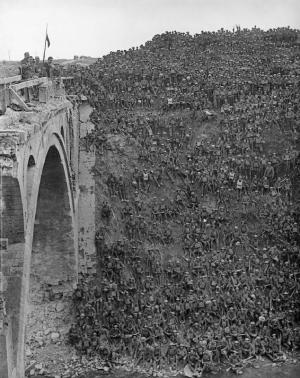
On 29th September the 46th Midland Division, carrying through a remarkable feat of arms, broke through the Hindenburg Line at Riqueval. There, flanked by the Americans and the Australians under a creeping barrage and fog, they crossed the St Quentin Canal using light bridges, rafts and lifebelts. They scaled a steep slope to rush in with bayonets and surprise the enemy who were confidently based in the allegedly impregnable "Siegfried Stellung". They took 4,200 prisoners for a loss of fewer than 800 casualties gaining 3 and a half miles in all. Midlanders still take pride in the fact that it was their boys and not the more famous, Highlanders, Canadians or ANZACS " who broke the line". This action was the climax to a very successful month where the Germans were by now outclassed in most departments.
The enemy was pushed back remorselessly in many theatres of war. In France a series of offensives resulted in the retaking of key positions - Peronne, Lens and Bellicourt. At St Mihiel the Americans launched their first large-scale operation acting on their own. On the 28th in Flanders we broke out of the Ypres Salient and as the war of movement returned, Messines and Passchendaele were recaptured. The Turks were in retreat in Palestine where Nazareth and Haifa were taken and Damascus threatened. Allied forces finally advanced in Salonika in northern Greece forcing the Bulgarians to seek an armistice. They ceased fighting on the 30th. (On the 29th Ludendorff had suffered a seizure and collapsed - the same day the German military demanded that an approach for an armistice be made immediately.)
The magnificent advances we had made, however, exacted a toll on our soldiers even when we were making a war-winning offensive. Our local community lost 9 young men in the month of September.
Four were to die in France. On the 5th Corporal George Arthur Mottram, 48th Brigade Royal Field Artillery (62144) was killed in action aged24. Buried in Sucrerie British Cemetery, Ablaine-St-Nazaire, north of Albert, he is also remembered on the civic memorial, St Bart's and on a family grave there. The grave also records the death of his brother-in-law Driver B W Rawson with whom he lived in Church Street, before their marriages. George had been a house painter by trade.
Three more local lads were to perish on the 27th. Gunner William Duffy of the 1st/7th Lancashire Fusiliers (26439) was killed in action aged 25. He is buried at Fifteen Ravine British Cemetery Villers-Plouich and remembered in St Bart's. What his connection with Wilmslow is is unclear as he was a Salford man who was born and enlisted there. One of 8 children of William and Mary Ann he lived in Ridgeway Street, Manchester and worked as a collar cutter in the textile trade.
Private Charles Henshall died aged 35 whilst serving with the 47th battalion Canadian Infantry (103080). He enlisted in Victoria, British Columbia in October 1915, having emigrated to Canada on the SS Corsican in May 1913. Before the war he had worked as a domestic gardener and was the son of William and Mary of Holly Cottage, Davenport Green. He is buried in Bourlon Wood Cemetery and St John's and St Bart's record his passing.
Another who served with the same Canadian battalion was Private Norman Jones (145572) aged 22. He went over the top at Raillencourt near Cambrai and never returned. He had left for Canada in July 1912 on the SS Virginia. His name is recorded on the Vimy Ridge memorial and in St John's. It is unclear at the moment what his precise link with Wilmslow/Alderley is.
Fighting in Belgium claimed 2 more local men. Westoutre British Cemetery, south west of Ypres, has the grave of Private James William Burgess of the 1st/6th Cheshires (15537). He was killed in action on the 15th aged 22. He was the eldest son of James and Jane of 6 Lydiate Lane, Alderley Edge where the local memorial and that of Wilmslow commemorate him. Like many he had been a domestic gardener.
Another soldier remembered on the Alderley Edge memorial is Lance Corporal Alfred Hudson, who died aged 30 on the 29th serving with the 15th Cheshires (45772). He was married to Annie of 59 Brook Lane and is remembered in the local churches, also at Tyne Cot. Born in Gatley, he worked as a gardener for his father, Henry. Alfred's outstanding bravery in previous battles had been recognised with a Military Medal.
Away from the Western Front, our locality was to lose 3 more brave men. Our second recipient of the Military Medal was Private Frank Brandreth of the 11th and later 13th Cheshires (49943). He died, aged 32, in a Prisoner of War camp in Mulheim, near Cologne, on the 5th. His award in 3rd Ypres August 1917 was for "gallant conduct and devotion to duty". Involved in very heavy fighting at Messines and later Passchendaele, he was captured during the German "Spring Offensive" of March 1918. He had worked as a gardener at Deanwater House (now the Deanwater Hotel) before the war. His brother, Robert, was killed in July 1917 near Ypres.
As we pushed back the Bulgarians in Salonika, we lost 2 more. On the 16th, 21 year old Private Dan (not Daniel) Massey, 12th Cheshires (35748) died of wounds. He was the second son of James and Sarah of 21 Oak Lane and had been an errand boy for Eastman's store in 1912, before being trained as a butcher. He is buried in Sarigol Military Cemetery, Kriston, Salonika and the civic memorial and Wilmslow Methodist mark his passing.
Another cemetery in Salonika (Karasouli) contains the resting place of Private Herbert Clarke, who died on the 16th, aged 26. He was killed in action fighting with the 9th South Lancashire Regiment (28754) and had formerly been with the Prince of Wales Volunteers (70711). He lived with his parents at 51 Gill Bent Road, Handforth but in May 1912 he married Hannah Heath of Woodford and worked as a gardener at Fulshaw Lodge.
Photograph: Brigadier General J V Campbelladdressing troops of the 137th Brigade (46th Division) from the Riqueval Bridge over the St Quentin Canal, from the collections of the Imperial War Museums. Copyright public domain.
Jon Armstrong and Alan Cooper with a contribution from Michael Scaife, Wilmslow Historical Society.
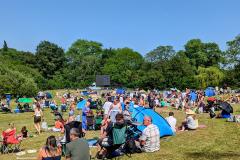
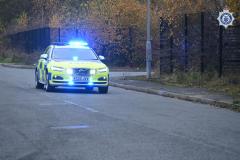


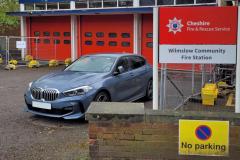


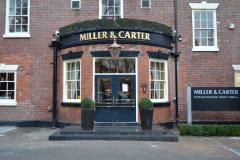

Comments
Here's what readers have had to say so far. Why not add your thoughts below.
Many thanks to all involved.